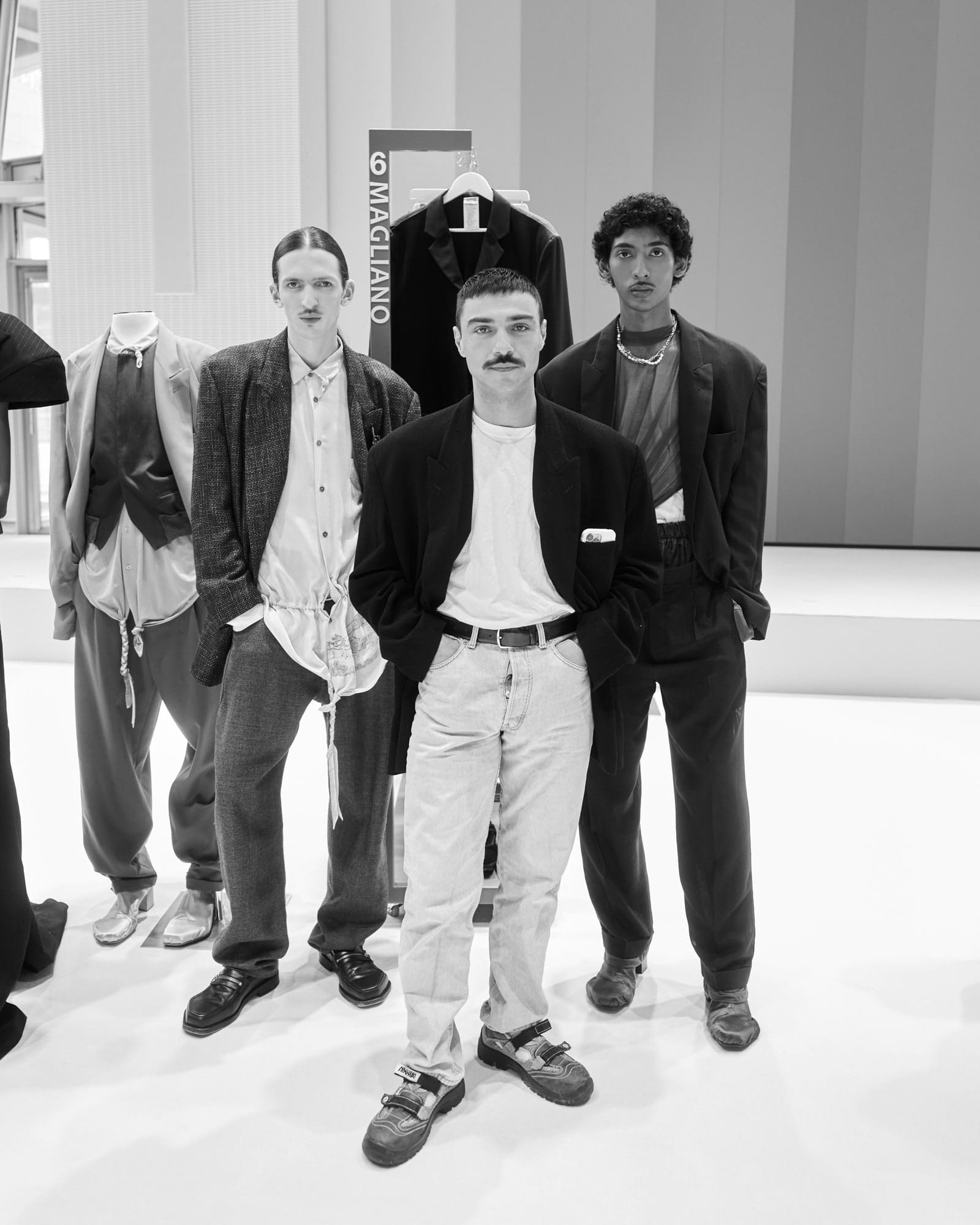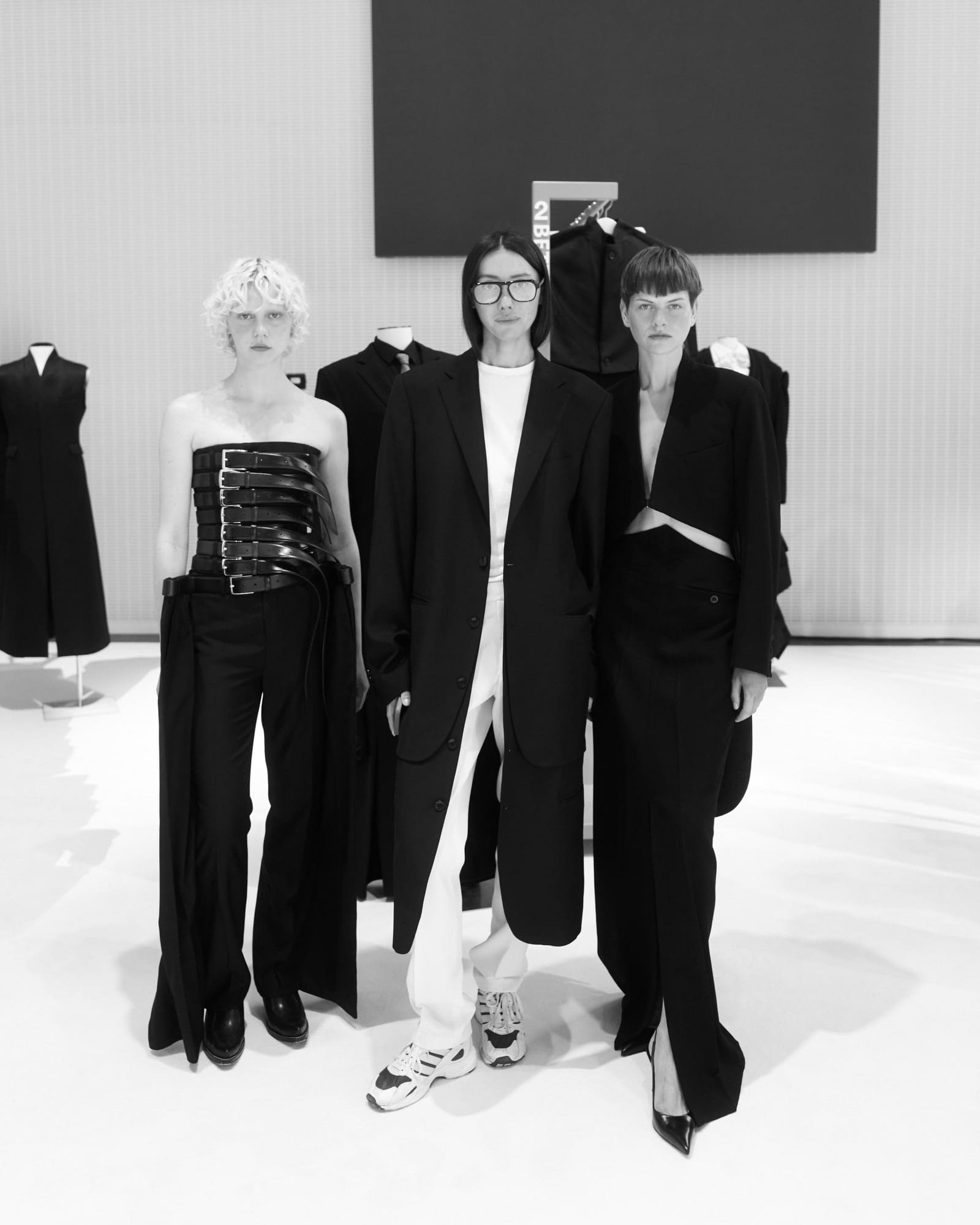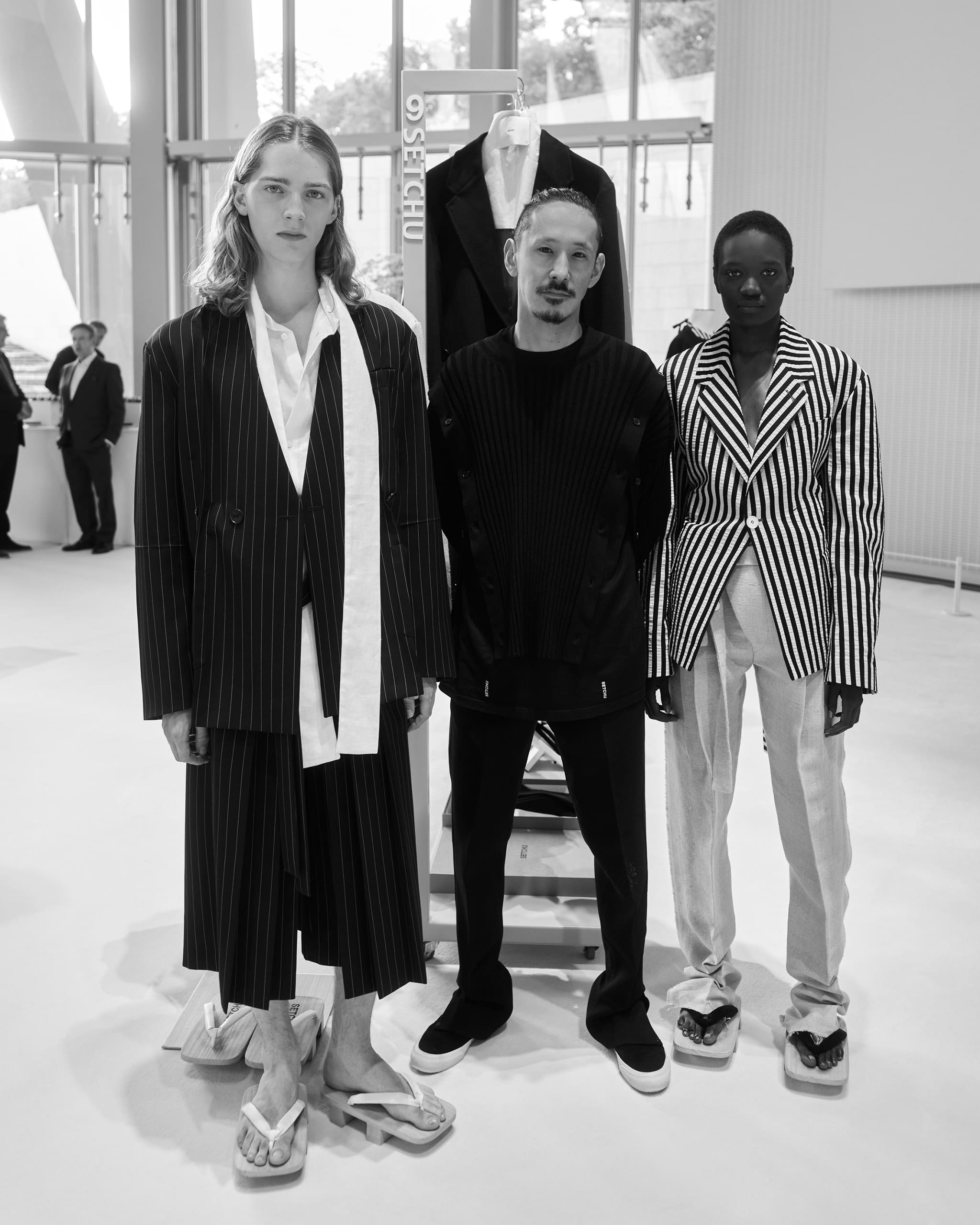Satoshi Kuwata and models in his looks. Photo: Courtesy of LVMH
Two weeks ahead of the Paris men’s collections, the Fondation Louis Vuitton was as buzzy as any runway show, with guests from across the industry turning up to support the young designers whose talents have been recognized by some of fashion’s biggest names.
For the nine finalists of the 2023 LVMH Prize, there was a before—the months of effort leading up to the climatic presentation; and there will be an after—determining what comes next and how they can maximize this invaluable experience.
But in the moments following the announcement (by none other than Gal Gadot) that Satoshi Kuwata had won for his brand, Setchu, there was only the present. “It’s still happening. I’m trying to digest it, but my brain isn’t following,” he said with full composure amidst the cameras and congratulations.
Nearby, Luca Magliano and Julie Pelipas, both awarded the Karl Lagerfeld Prize for their brands, Magliano and Bettter, were sticking together through the instant attention, holding the framed illustration that marked their achievement.
“I mean, it is huge, the size, the importance, the relevance. I don’t know how to explain how proud I am in this moment. It all feels beautiful,” gushed Magliano, who is based in Bologna and makes clothes (menswear with a genderless slant) that have a polished yet insouciant vibe.

Pelipas, who is Ukrainian but based in London, has developed an upcycling “system” that works towards zero waste. She seemed amazed that the judges were so enthusiastic about her concept. “It’s overwhelming how they not only understood but also got inspired. This type of feedback was beyond anything I expected; it’s a kind of approval from the industry, which is very important when you develop something very risky out of nothing.”
As this year marked the 10th anniversary of the LVMH Prize, there was an added sense of how significant the initiative has become. Already before the ceremony, experts seemed in agreement that the creation and execution of this cohort were as impressive as any previous edition.
Then, when the jury comprised of eight artistic directors from LVMH houses—Jonathan Anderson, Maria Grazia Chiuri, Stella McCartney, Marc Jacobs, Stella McCartney, Nicolas Ghesquière, Nigo, Silvia Venturini Fendi—arrived on stage, Delphine Arnault revealed a big surprise: The endowments had been increased by 100,000 euros each—€400,000 for the main prize and €200,000 for the Karl Lagerfeld Prize.
In a conversation, once the event had drawn to a close, Arnault noted “inflation” in semi-jest before explaining how the additional funds would go a long way. “It hadn’t been raised in a long time, and [€400,000] really helps. The designers have a big problem of cash flow—they have to buy fabrics and pay manufacturers before being paid by wholesale. And this can help create a bigger structure… and it helps them also with their shows. It’s a substantial amount.”
Pointing out that the LVMH Prize reflects currents in fashion at a given moment, she said that the early novelty of high-end streetwear has given way to the imperative of sustainability. “Everyone has integrated that into their brand. It has evolved a lot.”
Enter Bettter, which is arguably more disruptive in process than product. Like the other winners, Pelipas will receive ongoing mentorship along with the monetary winnings. Improving logistics, she said, is essential. “We’re going to invest in all the technology so that it’s scalable—a lot of brains are needed.”

According to Arnault, the jury arrived at consensus without much deliberation. “This time everyone agreed on who was going to win,” she said, adding that they discussed the finalists at lunchtime in the presence of her father, Bernard Arnault. “Everyone around the table expresses what they think—the strengths, the weaknesses, and why he or she should win. About Kuwata, she said, “he did an exceptional presentation. At the end, two of the jury members wanted to buy his jacket. I think he has a lot of talent and a promising future… everyone was pretty convinced.”
With the Fondation’s cascading fountain in the background, Kuwata distinguished this Prize from the others. “LVMH is a whole different level of organization; this kind of support is everything. I’m not going to build a group [like theirs], but my company will have a heritage in the future, and I would like to map out what is necessary with them because they are the heritage.”
Interestingly, even though Kuwata’s brand is just three years old, at 39, he would no longer have been eligible as of next year. Compared to his fellow designers, his entire positioning with Setchu is understated. The brand identity is clean and minimal. While some silhouettes express daring volumes, most looks are impeccably unstructured. There is an unmistakably Japanese aesthetic yet a freshness that Nigo called “the next creative approach for a new generation.” And he had nothing but praise for the other finalists. “Compared to last year, the talent was much higher, globally speaking.”
The remaining desingers—Aaron Esh, Burc Akyol, Diotima (Rachel Scott), Luar (Raul Lopez), Paolina Russo (Paolina Russo and Lucile Guilmard), and Quira (Veronica Leoni)—will have gained considerably from the exposure. If Grace Wales Bonner, Marine Serre and Thebe Megugu are among the alums who benefited from winning, Virgil Abloh, Coperni, Ludovic de Saint Sernin, and Y/Project’s Glenn Martens proved bona fide successes without the Prize.
Leoni, for one, declared it a “once-in-a-lifetime opportunity,” while Esh, despite saying he was “back to the drawing board” took a sanguine view. “I don’t think of it as a reflection on the quality of my work. Sometimes when the chips fall, they don’t fall on your part of the table, and whether that validates [the work] or not is irrelevant.” Beyond his own needs, Luar’s Lopez pointed out how being a finalist would have a trickle-down effect for those with similar aspirations. “A lot of people now know my brand and my story and that’s great because people who look like me or come from disturbed neighborhoods and weren’t able to go to fashion school, this shows you can actually do it,” said the self-taught, New York designer.
Steven Stokey Daley, last year’s winner, was making the rounds with ’21 laureate, Nensi Dojaka. Surely, they could sympathize with all the feels—the stress, the excitement, the countless unknowns. “They just need to use the momentum because it’s an important moment that brings a lot of things and it’s just about grabbing the opportunities,” said Dojaka, to which Daley recommended enjoying the first few weeks, “because they’re so magical in a way.”
Indeed, by the day’s end, several finalists were idling together before regrouping for a celebratory dinner. Magliano continued to radiate elation—affection, too. “I don’t want to abandon any of them. They are all family now.”
This article was originally published on Vogue.com
